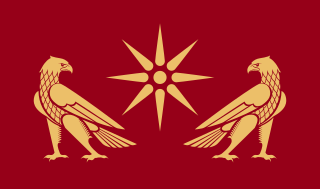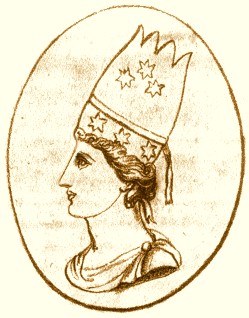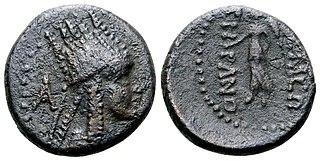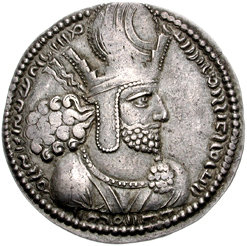This page is based on this
Wikipedia article Text is available under the
CC BY-SA 4.0 license; additional terms may apply.
Images, videos and audio are available under their respective licenses.

Atropatene was an ancient kingdom established and ruled under local ethnic Iranian dynasties, first with Darius III of Persia and later Alexander the Great of Macedonia starting in the 4th century BC and includes the territory of modern-day northern Iran, and a small part of the contemporary Azerbaijan Republic. Its capital was Ganzak. Atropatene also was the nominal ancestor of the name of the historic Azerbaijan region in Iran.

Phraates IV of Parthia, ruled the Parthian Empire from 37–2 BC. He was appointed successor to the throne in 37 BC, after the death of his brother Pacorus I. He soon murdered his father and all his thirty brothers.

Artavasdes II was a King of the Kingdom of Armenia from 55 BC until 34 BC and a member of the Artaxiad Dynasty. He was a son of king Tigranes the Great of Armenia and Cleopatra of Pontus, his maternal grandfather was king Mithridates IV of Pontus. Artavasdes II was an ally of Rome and when Marcus Licinius Crassus the Roman proconsul of Syria prepared an invasion of the Parthian Empire Artavasdes offered his assistance. Crassus, not willing to share the glory and spoils of defeating the Parthians, refused Artavasdes offer. The Romans suffered an unexpected defeat at the hands of the Parthian general Surenas while Orodes II, the Parthian king, invaded Armenia and forced Artavasdes to join the Parthians, he gave his sister in marriage to Orodes' son and heir Pacorus.

Artaxias II, also known as Artaxes II and Artashes was a Prince of the Kingdom of Armenia and member of the Artaxiad Dynasty King of Armenia from 30 BC until 20 BC.

Artavasdes I of Armenia reigned as King of Armenia from 159 BC to 123 BC and was the son of Artaxias I.

The Arsacid dynasty or Arshakuni, ruled the Kingdom of Armenia from 54 to 428. The dynasty was a branch of the Arsacid dynasty of Parthia. Arsacid Kings reigned intermittently throughout the chaotic years following the fall of the Artaxiad dynasty until 62 when Tiridates I secured Arsacid dynasty of Parthia rule in Armenia. An independent line of Kings was established by Vologases II in 180. Two of the most notable events under Arsacid rule in Armenian history were the conversion of Armenia to Christianity by Gregory the Illuminator in 301 and the creation of the Armenian alphabet by Mesrop Mashtots in c. 405. The reign of the Arsacids of Armenia marked the predominance of Iranianism in the country.

The Artaxiad dynasty or Ardaxiad dynasty ruled the Kingdom of Armenia from 189 BC until their overthrow by the Romans in AD 12. Their realm included Greater Armenia, Sophene and intermittently Lesser Armenia and parts of Mesopotamia. Their main enemies were the Romans, the Seleucids and the Parthians, against whom the Armenians had to conduct multiple wars.

Erato also known as Queen Erato was a princess of the Kingdom of Armenia and member of the Artaxiad Dynasty. She served as Roman client queen of Armenia from 10 BC until 2 BC with her brother-husband King Tigranes IV. After living in political exile for a number of years, she co-ruled as Roman client queen of Armenia from 6 until 12 with the Herodian Prince Tigranes V, her distant paternal relative. As a queen of Armenia, she may be viewed as one of the last hereditary rulers of her nation.

Tigranes I of Armenia reigned as King of Armenia from 115 BC to 95 BC. Artavasdes I did not leave any heir; his brother Tigranes ascended to the throne of the Artaxiads. According to Appian, Tigranes II was not the son of Artavasdes, but of Tigranes I.

Tigranes III was a Prince of the Kingdom of Armenia and member of the Artaxiad Dynasty who served as a Roman Client King of Armenia
Artavasdes IV of Armenia; also known as Artavasdes II of Atropatene; Artavasdes II of Media Atropatene and Armenia Major; Artavasdes II and Artavasdes was a Prince who served as King of Media Atropatene. During his reign of Media Atropatene, Artavasdes also served as a Roman Client King of Armenia Major.

Artavasdes I of Media Atropatene, also known as Artavasdes I of Atropatene, Artavasdes I and Artavasdes was a Prince who served as a King of Media Atropatene. Artavasdes I was an enemy of King Artavasdes II of Armenia and his son Artaxias II. He was a contemporary with the Ptolemaic Greek Queen Cleopatra VII and Roman Triumvir Mark Antony, as Artavasdes I was mentioned in their diplomatic affairs.
Artaxias IV or Artashir IV who is also known as Artaxias, Artashes, Artashes IV, Artashir, Ardases, Ardasir and Artases was a prince who served as a Sassanid client king of eastern Armenia from 422 until 428. Artaxias IV was the last Arsacid king of Armenia and the last person to hold the crown of the ancient Armenian Kingdom.
Artavasdes is the Hellenized form of the Iranian name Artavazhda. Variant renderings in Greek include Artabazos, Artabazes, Artabazanes and Artabasdos; in Armenian Artavazd; and in Latin Ardabastus or Artabasdus.
Khosrov IV, was a Prince who served as a Sassanid King of Arsacid Armenia, which flourished during the second half of the 4th century & first half of the 5th century, from 387 until 389.
Tigranes was an Armenian Prince of the Arsacid dynasty of Armenia who lived in the second half of the 4th century and possibly first half of the 5th century.
Arsaces was an Armenian Prince of the Arsacid dynasty of Armenia who lived in the second half of the 4th century and possibly first half of the 5th century.
Ariobarzanes II of Atropatene also known as Ariobarzanes of Media; Ariobarzanes of Armenia; Ariobarzanes II; Ariobarzanes II of Media Atropatene and Ariobarzanes was a Prince who served as King of Media Atropatene who ruled sometime from 28 BC to 20 BC until 4 and was appointed by the Roman emperor Augustus to serve as a Roman Client King of Armenia Major from 2 AD until 4.
Iotapa was a princess of Media Atropatene, daughter of King Artavasdes I of Media Atropatene. She was Queen consort of King Mithridates III of Commagene.












